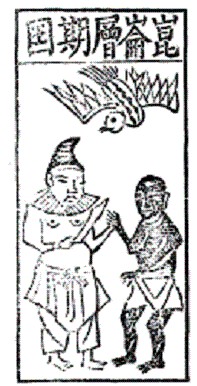To next page
Chou Ch'u-fei (1178) Ling-wai-tai-ta (Regions beyond mountain passes)
---------------------------------------------

Friedrich Hirth; Journal of the American oriental Society Vol XXX
Chao-yu-kua: Hirth & Rockhill
also called Zhou Qufei
A part in his work is called: Kuan-luan Tsang-kji or Qumr Zangi, this part got taken over by Chao Ju Kua.
Kouen-Louen ts'eng-k'i(the land of the blacks)
The land is situated in the sea of the south east. It is close to a big island. It is there that the big bird p'eng lives, in its flight, it momentarily obscures the sun. If the big p'eng meets a wild camel it eats it. If you happen to find a feather of the bird, you can use its quills to fashion a waterjar (repeated by Chao Ju-Kua) In this country also are found the ostriches whose necks are six or seven feet long. (Chou Ku-fei refers to it as camel-crane a transliteration of the Persian name for ostrich, 'shutur-murgh' meaning camel bird.)They can fly but not to any height. They eat all kinds of things, even burning fire. Sometimes (people) give them red-hot copper or iron to eat.
The products of the land are elephant tusks and rhino horns.
There is an island in the sea - Po-Pa-Li - on which you find many savages of which the body is as black as lack and who have curly hair. You attract them by offering them food. Thousands and ten thousands of them are taken and transported, as slaves to the land Ta-chi where they make a good price. They are used to guard the doors. It is said they are not homesick.
(He also describes a second Koulun, this one in Malaysia)
He mentions dragon spittle (ambergris) being imported from Murbat (He did not know it came originally from Africa)
Ma-li-pa (Mirbat)
The products (of Ma-li-pa) are frankincense, ambergris, pearls, opaque glass, rhinoceros horn, ivory, coral, putchuk, myrrh, dragon�s-blood, asa-futida, liquid storax, oak-galls and rose-water, to trade in all of which the countries of the Ta-shi resort to this place.
The people of Chan-ch'eng (Champa) buy male and female slaves and the ships carry human cargo.
See note on Zangi slaves
The most important festival of the country (Dai Viet) is on the 15th day of the seventh lunar month, when every family exchanges presents with others. The officials present Sheng-kou (slaves) to the king, who will give the officials a feast on the 16th day in return.